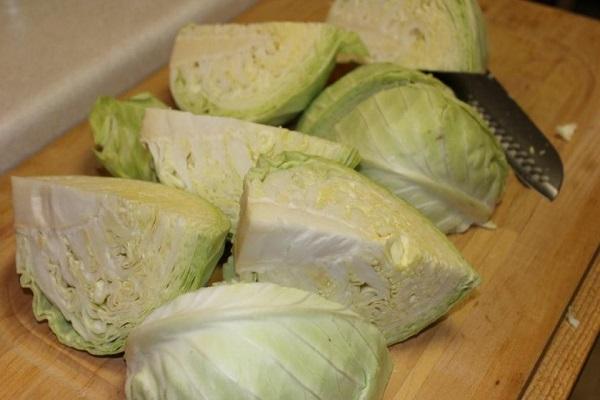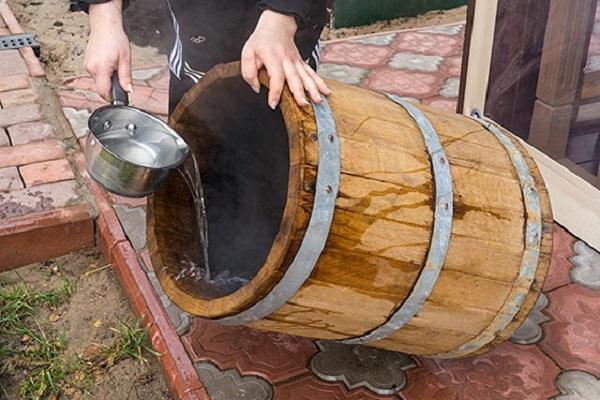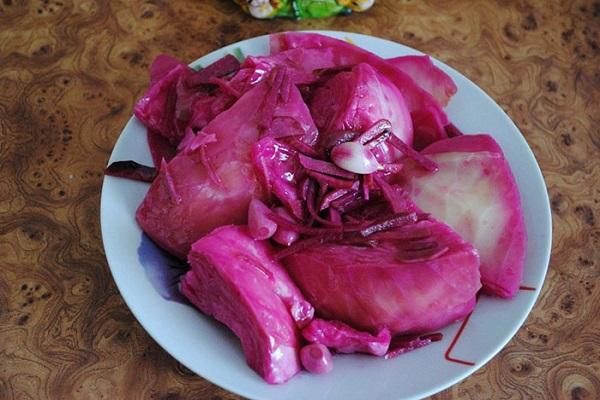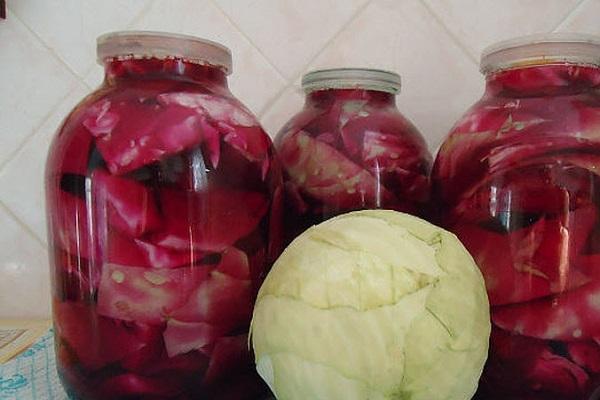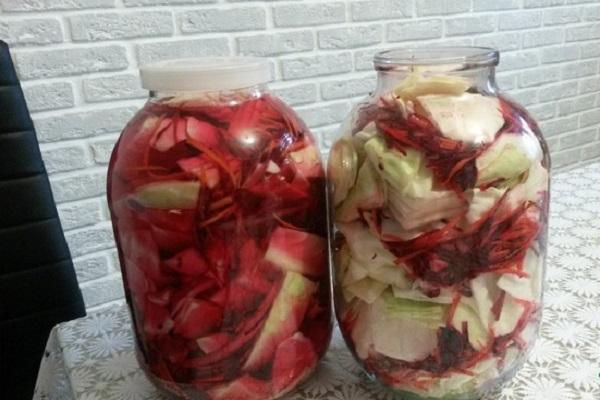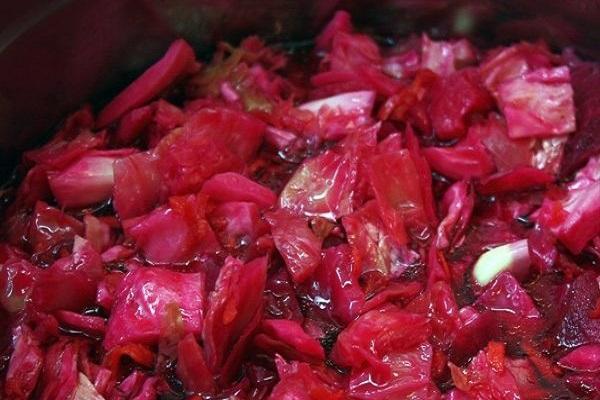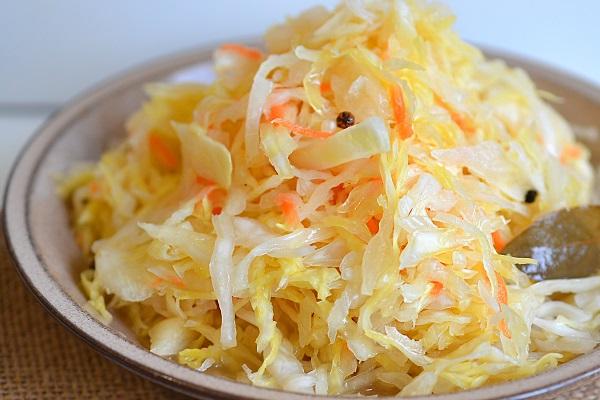A winter appetizer of sauerkraut with beets is a healthy preparation that contains many vitamins. The list of recipes is varied, but they are all easy to prepare if you know the subtleties and features. In any case, the dish turns out incredibly tasty, can be stored for a long time, and does not lose its nutritional qualities if you follow the preparation rules.
Features of preparing sauerkraut with beets for the winter
The use of beets for fermentation not only gives the appetizer a beautiful burgundy color, but also enriches it with unique beneficial substances that are found only in this root vegetable, in particular, unique vitamin U.
But it should be noted that sauerkraut with beets is not as crispy, so you should follow some rules.
How to choose and prepare vegetables
It is better to take winter varieties of cabbage for pickling, so they begin to ferment it in late September - early October.
The tighter and denser the head of cabbage, the better.
The beets should also be fully ripe by that time, since it is undesirable to use young root vegetables.
The top leaves from the heads of cabbage must be removed, the beets washed and the peel cut off with a knife. Next, depending on the chosen recipe:
- Chop the cabbage and grate the beets.
- Cut the head of cabbage in half, cut out the stalk and cut into small pieces of 3-7 cm, and cut the beets into thin circles or cubes.
How to properly prepare containers
Previously, oak barrels were used to ferment cabbage. Later they were replaced by ceramic dishes covered with glaze, or metal with an enameled coating. Modern housewives ferment it in 2 or 3 liter glass jars. To fill 1 liter you will need approximately 1 kg of finely shredded cabbage.
Whatever container is used for fermentation, it is recommended to wash it thoroughly using soda and then rinse. In addition, it is recommended to lubricate the inside of the container with honey, vegetable oil or vinegar.
Best Recipes
Cabbage and beetroot appetizer is loved by people of different countries and some of them have their own national recipes.
Sauerkraut with beets in large pieces
You can ferment cabbage in large pieces either with or without the addition of vinegar, depending on personal preference. In the first case, the jars can be sealed, which will increase the shelf life of the snack. But the second method is more preferable for those who follow a healthy diet.
Sauerkraut with beets in a jar
This is one of the simplest and most popular recipes.
How to cook:
- Place beets, cut into small cubes, at the bottom of a three-liter glass jar.
- Separately, chop the cabbage and grate the carrots, as in the classic recipe.
- Mix the chopped vegetables with salt in a bowl and place them in a jar, lightly compacting each new layer 2-3 cm thick.
- Cover with gauze and place the jar on a plate into which the juice formed during the fermentation process will drain.
Every day, the vegetable mixture should be pierced with a long wooden stick to release gases.
Instant recipe
The appetizer will quickly acquire the sourness inherent in sauerkraut if you use vinegar, and it is better to use apple cider vinegar for this purpose. Prepare the marinade by boiling water with salt, black peppercorns, bay leaf and a small amount of vegetable oil. Before turning off the heat, pour vinegar into the boiling mixture.
For 1 liter of water:
- 2 tbsp. l. salt;
- 1 tbsp. l. refined vegetable oil;
- 6 tbsp. l. 9% vinegar;
- 3-5 black peppercorns;
- 1-3 bay leaves.
Place cabbage cut into pieces, slices of beets and garlic, and spicy herbs, slightly mashed in your hands, into a container. Pour over hot marinade. After a day, the quick snack is ready to eat.
In Georgian
The peculiarity of the Georgian snack is that you first need to boil water with salt and spices and cool the resulting marinade.
Cut the head of cabbage into pieces and the beets into slices. The proportions of cabbage and beets are approximately 3:1.
You will also need:
- celery greens – 1-2 bunches;
- garlic – 1-3 heads, cut into thin slices;
- hot pepper - 1-2 pods, seeded and cut into slices.
Place cabbage and beets in layers in a jar, sprinkle with herbs and spices, pour in cooled brine and press down on top with a small weight. Leave in a warm place for several days until the fermentation process is complete.
In Armenian
This recipe is very similar to the Georgian one, only it needs to be supplemented with carrots and cilantro. Vinegar is also not included in it, but for flavoring take a little cinnamon.
In Korean
Korean sauerkraut has a spicy taste; hot pepper is added to it, and in addition, the marinade is prepared with vinegar.
Vegetables are prepared in the usual way and placed in jars along with garlic. Pour in hot marinade and allow to cool. After a short amount of time, this snack is ready to eat.
In Gurian
The Gurian recipe is a variation of the Georgian one, the difference is in the use of hot marinade instead of cold. Intersperse pieces of cabbage with slices of beets and cloves of garlic, pour hot marinade over them and, after cooling, store in a cool place.
Terms and conditions of storage
Depending on whether the snack is prepared with vinegar or without it, its shelf life will be different. Pickled vegetables can be safely stored in a cool, shaded place for a year. But if vinegar is not specified in the recipe, then by spring cabbage sauerkraut in its own juice becomes more sour and soft. Its shelf life can be increased by keeping it in the refrigerator, but not in the freezer.

